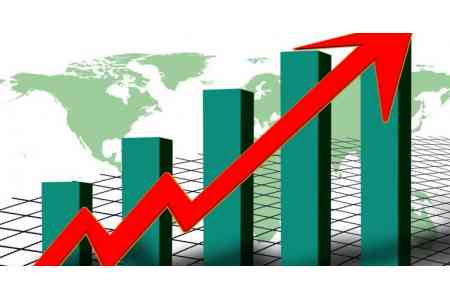


ArmInfo. In 2024, Armenia's GDP growth rate slowed down to 5.9% (from 8.3% in 2023 and 12.6% in 2022). The absolute value of Armenia's GDP in 2024 exceeded 10.127 trillion drams ($25.8 billion). The GDP deflator index also decreased to 101.1% in 2024, down from 102.7% in 2023 and 108% in 2022). This is evidenced by data from the RA Statistical Committee published on February 20.
In quarterly terms, Armenia's GDP, experienced a 35.3% decline in the first quarter of 2024, but then grew by 15.6% in the second quarter, and accelerated to 25.6% in the third quarter. A slowdown was noted in the fourth quarter - to 10.4%. Comparaaatively, in 2023, the quarterly GDP dynamics were similar: a 36.3% decline in the first quarter was followed by a 16.5% growth in the second quarter, accelerating to 27% in the third quarter, and then slowing down in the fourth quarter to 14.4%. GDP per capita in 2024 increased by 4.1%, reaching 3.338 million drams ($8.501 thousand or 7.857 thousand euros), compared to 3.206 million drams ($8.168 thousand or 7.463 thousand euros) in the previous year. This growth in per capita GDP is notable against the backdrop of an annual increase in the population of Armenia by 84.6 thousand people, bringing the total to 3.076 million people. A similar trend was observed in 2023, when per capita GDP grew by 12% alongside an increase in the population by 53.7 thousand people (from 2.938 million to 2.991 million people - according to updated data).
However, we note that the population growth is recorded not so much due to natural growth, but due to the citizens of Artsakh forcibly displaced to Armenia after the tragic events of September 2023. Thus, the absolute value of the natural population growth of Armenia in 2024 amounted to 8,072 thousand people (against 12,277 thousand people in 2023), having decreased by 34.3% (against an increase of 26.8% in 2023). The drivers of GDP growth in 2024 were, to a greater extent, the trade sector - 17%, the construction sector - 14.5% and the services sector - 10.6%. To a lesser extent the energy complex - 6.5%, the industrial sector - 4.7% and the agricultural sector - 1.6% contributed to the growth. For comparison, it should be noted that in 2023, only the agricultural sector was in decline - 0.3%, while other sectors demonstrated higher growth: trade - 25.7%, construction - 14.8%, services - 10.3%, and the industrial sector - 4.1%.
Against this background, the growth rate of Armenia's foreign trade turnover slowed slightly from 46% to 41.5%, which came from an imperceptible slowdown in the growth of both exports from 55.3% to 53.1% and imports from 40.2% to 33.8%. Moreover, the growth of foreign trade was mainly supported by impressive volumes of export and import of precious metals and stones ($8 billion and $7.4 billion, respectively, with an annual growth of 2.5-2.7 times). With the clarification of experts, referring to the small scale production within the jewelry industry, we are talking about the re-export and re-import of gold and diamonds. According to semi-annual customs data, the majority of gold is imported from Russia (95.9%) and then exported to the UAE (84.2%). The predominant volume of diamonds comes from India (45.2%), Russia (21.4%) and Hong Kong (19.7%), also being exported to the UAE (82.7%).
It should be noted that the Central Bank's forecast of 6% closely matched Armenia's actual GDP growth for 2024. The International Monetary Fund also predicted a 6% growth for Armenia's GDP for 2024, while the World Bank had a more modest figure of 5.5%. Moreover, both the IMF and the World Bank anticipate a further slowdown in GDP growth rates in 2025 to 4.9% and 5%, respectively. The Central Bank predicts either an acceleration in GDP growth rates to 7.1% or a slowdown to 4.8% for 2025, depending on the trajectory of inflation.